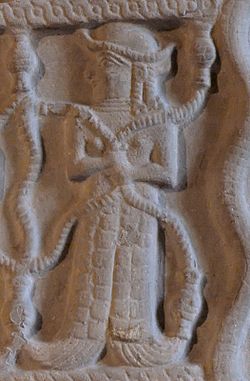Top Qs
Timeline
Chat
Perspective
Untash-Napirisha
King of Elam From Wikipedia, the free encyclopedia
Remove ads
Untash-Napirisha was king of Elam (in present-day southwest Iran) during the Middle Elamite period, circa 1300 BCE. He was the son of the previous Elamite king, Humban-Numena and of a daughter[4] (or granddaughter)[2] of Kurigalzu.[4] He was named after Napirisha, an Elamite deity.
He founded and built extensively a new city, Dur-Untash, 40 km SE of Susa, modern Chogha Zanbil. He built extensively in this city, and its main temple, the famous Ziggurat, still stands there.[5] Although construction in this religious city complex abruptly ended after Untash-Napirisha's death, the site was not abandoned, but continued to be occupied until it was destroyed by the Assyrian king Ashurbanipal in 640 BC.
Untash-Napirirsha also left numerous building inscriptions for more than 50 temples and buildings, either built or renovated during his reign, in Chogha Zanbil, Susa, Choga Gotvand and other places.[6]
He dedicated a statue of the god Immiriya in Chogha Zanbil to his father-in-law, the Babylonian Burnaburiash.[a][8][9] A later Elamite letter from Berlin (Pergamon Museum VAT17020) mentions that he was married to “the daughter of Burna-buriash (a Babylonian king) and they had a son (and the future Elamite king) Kidin-hudurdish (Hutran)".[10] If this was the Babylonian king Burna-Buriash II, then the reign of Untash-Napirisha could be dated ca. 1340–1300 BC. However, some scholars consider a different model for the synchronism between the Kassite dynasty in Babylon and the Elamite kings, and suggest that the mentioned Burna-buriash was a later prince, and that the reign of Untash-Napirisha could be dated c. 1275–1240 BC; see, for example The Berlin Letter, Middle Elamite Chronology and Sutruk-Nahhunte I's Genealogy.[11]
- Axe bearing the name of the king Untash-Napirisha.
- Axe inscribed with the name of King Untash-Napirisha
- The Ziggurat at Chogha Zanbil was built by Untash-Napirisha.
- Fish-tailed deity holding snakes. Stele of Untash Napirisha, sandstone, ca. 1340–1300 BC, brought from Tchoga Zanbil to Susa in the 12th century BC.[12]
- Plaque with inscription "Palace of Untash-Napirisha" from Chogha Zanbil
Remove ads
Notes
- In the dedication, the part of the text mentioning the Babylonian king is damaged. In François Vallat's opinion, shared by Daniel T. Potts, […-l]i-ia-áš should be read as [Bur-na]-bur-ia-áš; E. Reiner prefers a geographical interpretation, proposing [tup-l]i-ia-áš; according to other historians, the damaged text should be restored as [kaš-ti-l]i-ia-áš, actually referring to Kashtiliash IV.[7]
References
Wikiwand - on
Seamless Wikipedia browsing. On steroids.
Remove ads






